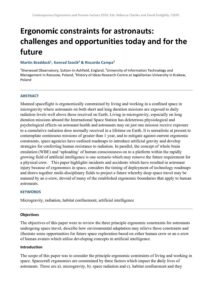| Document | Author Martin Braddock, Konrad Szocik & Riccardo Campa |
| Abstract Manned spaceflight is ergonomically constrained by living and working in a confined space in microgravity where astronauts on both short and long duration missions are exposed to daily radiation levels well above those received on Earth. Living in microgravity, especially on long duration missions aboard the International Space Station has deleterious physiological and psychological effects on astronaut health and astronauts may on just one mission receive exposure to a cumulative radiation dose normally received in a lifetime on Earth. It is unrealistic at present to contemplate continuous missions of greater than 1 year, and to mitigate against current ergonomic constraints, space agencies have outlined roadmaps to introduce artificial gravity and develop strategies for conferring human resistance to radiation. In parallel, the concept of whole brain emulation (WBE) and ‘uploading’ of human consciousness on to a platform within the rapidly growing field of artificial intelligence is one scenario which may remove the future requirement for a physical crew. This paper highlights incidents and accidents which have resulted in astronaut injury because of ergonomics in space, considers the timing of deployment of technology roadmaps and draws together multi-disciplinary fields to project a future whereby deep space travel may be manned by an e-crew, devoid of many of the established ergonomic boundaries that apply to human astronauts. |

